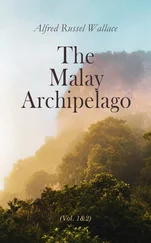Alfred Wallace - Contributions to the Theory of Natural Selection
Здесь есть возможность читать онлайн «Alfred Wallace - Contributions to the Theory of Natural Selection» — ознакомительный отрывок электронной книги совершенно бесплатно, а после прочтения отрывка купить полную версию. В некоторых случаях можно слушать аудио, скачать через торрент в формате fb2 и присутствует краткое содержание. Жанр: foreign_prose, foreign_edu, foreign_antique, на английском языке. Описание произведения, (предисловие) а так же отзывы посетителей доступны на портале библиотеки ЛибКат.
- Название:Contributions to the Theory of Natural Selection
- Автор:
- Жанр:
- Год:неизвестен
- ISBN:нет данных
- Рейтинг книги:4 / 5. Голосов: 1
-
Избранное:Добавить в избранное
- Отзывы:
-
Ваша оценка:
- 80
- 1
- 2
- 3
- 4
- 5
Contributions to the Theory of Natural Selection: краткое содержание, описание и аннотация
Предлагаем к чтению аннотацию, описание, краткое содержание или предисловие (зависит от того, что написал сам автор книги «Contributions to the Theory of Natural Selection»). Если вы не нашли необходимую информацию о книге — напишите в комментариях, мы постараемся отыскать её.
Contributions to the Theory of Natural Selection — читать онлайн ознакомительный отрывок
Ниже представлен текст книги, разбитый по страницам. Система сохранения места последней прочитанной страницы, позволяет с удобством читать онлайн бесплатно книгу «Contributions to the Theory of Natural Selection», без необходимости каждый раз заново искать на чём Вы остановились. Поставьте закладку, и сможете в любой момент перейти на страницу, на которой закончили чтение.
Интервал:
Закладка:
It has been already mentioned that in South America there is a group of Papilios which have all the characteristics of a protected race, and whose peculiar colours and markings are imitated by other butterflies not so protected. There is just such a group also in the East, having very similar colours and the same habits, and these also are mimicked by other species in the same genus not closely allied to them, and also by a few of other families. Papilio hector, a common Indian butterfly of a rich black colour spotted with crimson, is so closely copied by Papilio romulus, that the latter insect has been thought to be its female. A close examination shows, however, that it is essentially different, and belongs to another section of the genus. Papilio antiphus and P. diphilus, black swallow-tailed butterflies with cream-coloured spots, are so well imitated by varieties of P. theseus, that several writers have classed them as the same species. Papilio liris, found only in the island of Timor, is accompanied there by P. ænomaus, the female of which so exactly resembles it that they can hardly be separated in the cabinet, and on the wing are quite undistinguishable. But one of the most curious cases is the fine yellow-spotted Papilio cöon, which is unmistakeably imitated by the female tailed form of Papilio memnon. These are both from Sumatra; but in North India P. cöon is replaced by another species, which has been named P. doubledayi, having red spots instead of yellow; and in the same district the corresponding female tailed form of Papilio androgeus, sometimes considered a variety of P. memnon, is similarly red-spotted. Mr. Westwood has described some curious day-flying moths (Epicopeia) from North India, which have the form and colour of Papilios of this section, and two of these are very good imitations of Papilio polydorus and Papilio varuna, also from North India.
Almost all these cases of mimicry are from the tropics, where the forms of life are more abundant, and where insect development especially is of unchecked luxuriance; but there are also one or two instances in temperate regions. In North America, the large and handsome red and black butterfly Danais erippus is very common; and the same country is inhabited by Limenitis archippus, which closely resembles the Danais, while it differs entirely from every species of its own genus.
The only case of probable mimicry in our own country is the following:—A very common white moth (Spilosoma menthastri) was found by Mr. Stainton to be rejected by young turkeys among hundreds of other moths on which they greedily fed. Each bird in succession took hold of this moth and threw it down again, as if too nasty to eat. Mr. Jenner Weir also found that this moth was refused by the Bullfinch, Chaffinch, Yellow Hammer, and Red Bunting, but eaten after much hesitation by the Robin. We may therefore fairly conclude that this species would be disagreeable to many other birds, and would thus have an immunity from attack, which may be the cause of its great abundance and of its conspicuous white colour. Now it is a curious thing that there is another moth, Diaphora mendica, which appears about the same time, and whose female only is white. It is about the same size as Spilosoma menthastri, and sufficiently resembles it in the dusk, and this moth is much less common. It seems very probable, therefore, that these species stand in the same relation to each other as the mimicking butterflies of various families do to the Heliconidæ and Danaidæ. It would be very interesting to experiment on all white moths, to ascertain if those which are most common are generally rejected by birds. It may be anticipated that they would be so, because white is the most conspicuous of all colours for nocturnal insects, and had they not some other protection would certainly be very injurious to them.
Lepidoptera mimicking other Insects
In the preceding cases we have found Lepidoptera imitating other species of the same order, and such species only as we have good reason to believe were free from the attacks of many insectivorous creatures; but there are other instances in which they altogether lose the external appearance of the order to which they belong, and take on the dress of bees or wasps—insects which have an undeniable protection in their stings. The Sesiidæ and Ægeriidæ, two families of day-flying moths, are particularly remarkable in this respect, and a mere inspection of the names given to the various species shows how the resemblance has struck everyone. We have apiformis, vespiforme, ichneumoniforme, scoliæforme, sphegiforme (bee-like, wasp-like, ichneumon-like, &c.) and many others, all indicating a resemblance to stinging Hymenoptera. In Britain we may particularly notice Sesia bombiliformis, which very closely resembles the male of the large and common humble bee, Bombus hortorum; Sphecia craboniforme, which is coloured like a hornet, and is (on the authority of Mr. Jenner Weir) much more like it when alive than when in the cabinet, from the way in which it carries its wings; and the currant clear-wing, Trochilium tipuliforme, which resembles a small black wasp (Odynerus sinuatus) very abundant in gardens at the same season. It has been so much the practice to look upon these resemblances as mere curious analogies playing no part in the economy of nature, that we have scarcely any observations of the habits and appearance when alive of the hundreds of species of these groups in various parts of the world, or how far they are accompanied by Hymenoptera, which they specifically resemble. There are many species in India (like those figured by Professor Westwood in his “Oriental Entomology”) which have the hind legs very broad and densely hairy, so as exactly to imitate the brush-legged bees (Scopulipedes) which abound in the same country. In this case we have more than mere resemblance of colour, for that which is an important functional structure in the one group is imitated in another whose habits render it perfectly useless.
Mimicry among Beetles
It may fairly be expected that if these imitations of one creature by another really serve as a protection to weak and decaying species, instances of the same kind will be found among other groups than the Lepidoptera; and such is the case, although they are seldom so prominent and so easily recognised as those already pointed out as occurring in that order. A few very interesting examples may, however, be pointed out in most of the other orders of insects. The Coleoptera or beetles that imitate other Coleoptera of distinct groups are very numerous in tropical countries, and they generally follow the laws already laid down as regulating these phenomena. The insects which others imitate always have a special protection, which leads them to be avoided as dangerous or uneatable by small insectivorous animals; some have a disgusting taste (analogous to that of the Heliconidæ); others have such a hard and stony covering that they cannot be crushed or digested; while a third set are very active, and armed with powerful jaws, as well as having some disagreeable secretion. Some species of Eumorphidæ and Hispidæ, small flat or hemispherical beetles which are exceedingly abundant, and have a disagreeable secretion, are imitated by others of the very distinct group of Longicornes (of which our common musk-beetle may be taken as an example). The extraordinary little Cyclopeplus batesii, belongs to the same sub-family of this group as the Onychocerus scorpio and O. concentricus, which have already been adduced as imitating with such wonderful accuracy the bark of the trees they habitually frequent; but it differs totally in outward appearance from every one of its allies, having taken upon itself the exact shape and colouring of a globular Corynomalus, a little stinking beetle with clubbed antennæ. It is curious to see how these clubbed antennæ are imitated by an insect belonging to a group with long slender antennæ. The sub-family Anisocerinæ, to which Cyclopeplus belongs, is characterised by all its members possessing a little knob or dilatation about the middle of the antennæ. This knob is considerably enlarged in C. batesii, and the terminal portion of the antennæ beyond it is so small and slender as to be scarcely visible, and thus an excellent substitute is obtained for the short clubbed antennæ of the Corynomalus. Erythroplatis corallifer is another curious broad flat beetle, that no one would take for a Longicorn, since it almost exactly resembles Cephalodonta spinipes, one of the commonest of the South American Hispidæ; and what is still more remarkable, another Longicorn of a distinct group, Streptolabis hispoides, was found by Mr. Bates, which resembles the same insect with equal minuteness,—a case exactly parallel to that among butterflies, where species of two or three distinct groups mimicked the same Heliconia. Many of the soft-winged beetles (Malacoderms) are excessively abundant in individuals, and it is probable that they have some similar protection, more especially as other species often strikingly resemble them. A Longicorn beetle, Pæciloderma terminale, found in Jamaica, is coloured exactly in the same way as a Lycus (one of the Malacoderms) from the same island. Eroschema poweri, a Longicorn from Australia, might certainly be taken for one of the same group, and several species from the Malay Islands are equally deceptive. In the Island of Celebes I found one of this group, having the whole body and elytra of a rich deep blue colour, with the head only orange; and in company with it an insect of a totally different family (Eucnemidæ) with identically the same colouration, and of so nearly the same size and form as to completely puzzle the collector on every fresh occasion of capturing them. I have been recently informed by Mr. Jenner Weir, who keeps a variety of small birds, that none of them will touch our common “soldiers and sailors” (species of Malacoderms), thus confirming my belief that they were a protected group, founded on the fact of their being at once very abundant, of conspicuous colours, and the objects of mimicry.
Читать дальшеИнтервал:
Закладка:
Похожие книги на «Contributions to the Theory of Natural Selection»
Представляем Вашему вниманию похожие книги на «Contributions to the Theory of Natural Selection» списком для выбора. Мы отобрали схожую по названию и смыслу литературу в надежде предоставить читателям больше вариантов отыскать новые, интересные, ещё непрочитанные произведения.
Обсуждение, отзывы о книге «Contributions to the Theory of Natural Selection» и просто собственные мнения читателей. Оставьте ваши комментарии, напишите, что Вы думаете о произведении, его смысле или главных героях. Укажите что конкретно понравилось, а что нет, и почему Вы так считаете.












